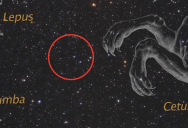Watch What Happened When The Hubble Telescope Focused On “Nothing” For 100 Hours
You’ve probably seen at least some of the amazing images captured by NASA’s Hubble telescope over the years, and even though it’s no longer the most powerful telescope in the game, there’s no denying they’re stunning.
What happens, though, when you point it at “nothing?”
Let’s find out!
It started in 1994, when the director of the Space Telescope Science Institute in Baltimore found a seemingly empty patch of sky and pointed the Hubble that direction for a full 100 hours.

See, the Hubble was still fairly new, and no one was 100% sure of its capabilities – basically, they wanted to know what it could see.
Robert Williams was an astronomer in charge of the Hubble’s operations at the time, and believed that the telescope could see far more than other telescopes at the time.
“We didn’t know what was there, and that was the whole purpose of the observation, basically – to get a core sample of the universe. You do the same thing if you’re trying to understand the geology of the Earth: Pick some typical spot to drill down to try to understand exactly what the various layers of the Earth are and what they mean in terms of its geologic history.”

The area he settled on was about the size of a pin held an arm’s length away, near the Big Dipper.
The piece of space was anything but empty.

The result was Hubble Deep Field, the deepest view of the universe at that point.
They saw galaxies, and learned things about the state of the universe billions of years in the past.
Check it out!
So where we thought there was nothing, there was more than a little something.
And as those in the know probably suspected at the time, the magic was just beginning.
If you enjoyed that story, check out what happened when a guy gave ChatGPT $100 to make as money as possible, and it turned out exactly how you would expect.

Sign up to get our BEST stories of the week straight to your inbox.




